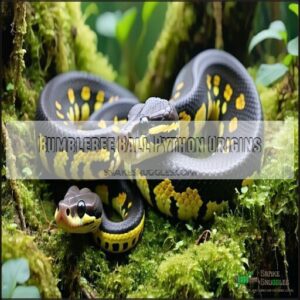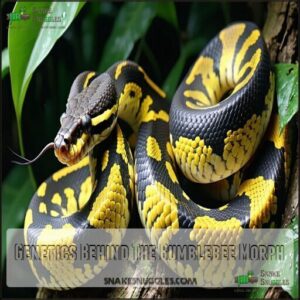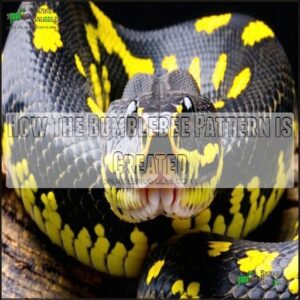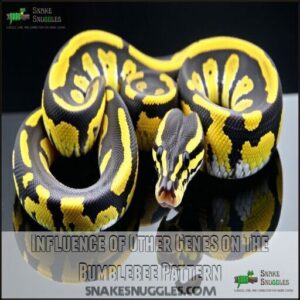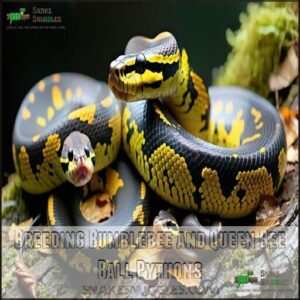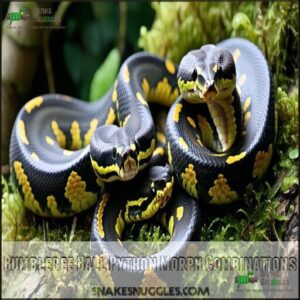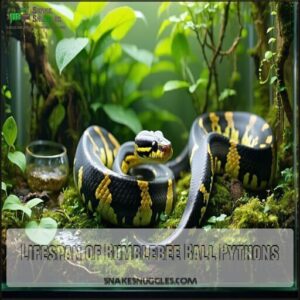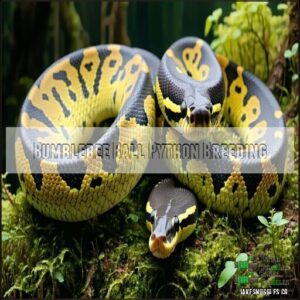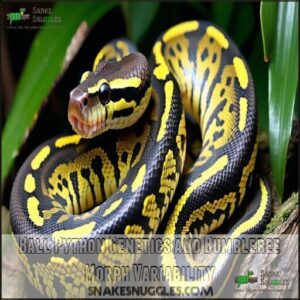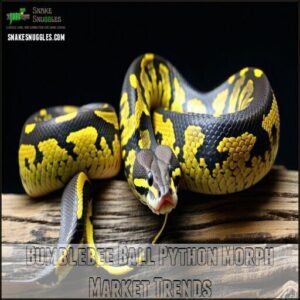This site is supported by our readers. We may earn a commission, at no cost to you, if you purchase through links.
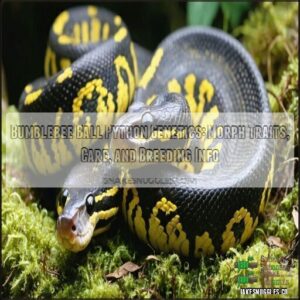
When you breed a pastel ball python with a spider, the offspring may inherit the signature bright yellow and black “bumblebee” pattern.
However, spider morphs are linked to a neurological condition called a wobble, which can cause head tilting or uncoordinated movements. While it doesn’t usually affect their lifespan, it’s something breeders should monitor.
Bumblebees can also be paired with other morphs for unique results. Curious about which combinations produce the most striking patterns? There’s plenty more to explore in their genetics!
Table Of Contents
- Key Takeaways
- Bumblebee Ball Python Origins
- Genetics Behind The Bumblebee Morph
- Bumblebee Ball Python Color Genetics
- Bumblebee and Queen Bee Ball Python Genetics
- Bumblebee Ball Python Morph Combinations
- Lifespan of Bumblebee Ball Pythons
- Bumblebee Ball Python Breeding
- Bumblebee Ball Python Health and Genetics
- Ball Python Genetics and Bumblebee Morph Variability
- Bumblebee Ball Python Morph Market Trends
- Frequently Asked Questions (FAQs)
- What genes are in a bumblebee Ball Python?
- What genes make a Batman Ball Python?
- What makes a killer bee Ball Python?
- Are Bumblebee ball pythons genetic?
- What is a bumblebee ball python morph?
- Are Bumblebee and Queen Bee Ball pythons the same?
- What color is a bumblebee ball python?
- Why are Bumblebee ball pythons so popular?
- What are the different types of Bumble Bee Ball pythons?
- What morphs make a bumblebee ball python?
- Conclusion
Key Takeaways
- You’ll create a bumblebee ball python by combining pastel and spider genes, resulting in their signature bright yellow and black coloration.
- Spider genes in bumblebees come with a risk of genetic neurological issue, a condition that affects balance but isn’t typically life-threatening.
- Breeding bumblebees with other morphs, like albino or clown, can produce unique patterns and colors while improving visual traits.
- Ethical breeding practices are crucial to avoid serious genetic issues, like lethality in super spiders, and ensure healthy offspring.
Bumblebee Ball Python Origins
The bumblebee ball python originated in 2001 when breeders combined pastel and spider genes to create a striking new morph.
Bumblebee ball pythons debuted in 2001, dazzling enthusiasts with their vibrant yellow-and-black patterns from pastel and spider genetics.
It quickly became a sought-after designer snake due to its bold colors and genetic uniqueness.
History of The Bumblebee Ball Python Morph
The bumblebee ball python morph originated with breeders experimenting with new reptile genetics.
By pairing pastel and spider ball python morphs, they revealed a striking yellow-and-black coloration that revolutionized snake morphs. This breakthrough wasn’t just a visual spectacle but a milestone in bumblebee genetics.
Here’s how it developed:
- Initial Breeders: In 2001, New England Reptile Distributors (NERD) created the first bumblebee ball python, calling it a pastel spider.
- Morphs Origin: Combining codominant pastel and spider genes delivered stunning, contrasting patterns.
- Early Popularity: Enthusiasts embraced this discovery, sparking a naming controversy as "pastel spider" evolved into "bumblebee ball python."
The bumblebee morph opened doors to designer colors, marking its historical significance in reptile genetics.
Development of The Bumblebee Ball Python Genetics
The origins of bumblebee genetics showcase the careful art of combining pastel and spider genes.
This pairing creates the iconic yellow-and-black pattern seen in these ball python morphs.
However, the spider mutation’s wobble inheritance highlights breeding ethics as breeders balance visual appeal with snake health.
Their work fuels ongoing future research into snake morphs, addressing mutation impact while perfecting python genetics for hobbyists and enthusiasts alike, which is crucial for understanding the ongoing future research.
Breeders and Their Contributions to The Bumblebee Ball Python
Early bumblebee breeders transformed python breeding by blending genetic innovation with ethical breeding practices.
Their efforts didn’t just enhance the bumblebee ball python’s unique genetic traits—they popularized ball python morphs worldwide.
Breeders prioritized healthy snake breeding, ensuring traits like vibrant color or patterns wouldn’t overshadow a snake’s well-being.
These pioneers influenced morph popularization and set future breeding goals to refine quality while addressing challenges like the spider wobble.
Thanks to their expertise, the bumblebee morph thrives today.
Genetics Behind The Bumblebee Morph
The bumblebee ball python’s striking pattern comes from the combination of two specific genes: pastel and spider.
These codominant traits work together to create its unique coloration, but they also raise important considerations for breeding.
Dominant and Recessive Genes in Bumblebee Ball Pythons
The genetics behind bumblebee ball pythons combine fascinating principles of dominant, co-dominant, and recessive traits.
The Spider gene shows dominance, meaning it only needs one allele to appear, while recessive traits require two matching alleles to show visually.
The Spider gene dominates with just one allele, creating bold patterns, while recessive traits need two to shine.
Pastel codominance blends traits, enhancing the bumblebee morph’s vibrant yellow and black pattern.
However, the Spider gene carries risks, like head wobble genetics linked to neurological issues.
Super Spider lethality adds another layer of complexity to breeding probabilities.
- Traits to know:
- Spider Gene Dominance
- Pastel Codominance
- Super Spider Lethality
- Understanding dominant genes
- Managing head wobble genetics
Inheritance Patterns of The Bumblebee Gene
In the context of snake genetics, bumblebee ball pythons inherit dominant genes like Spider and Pastel in unique ways.
Here’s how it works:
- Gene dominance: Dominant genes overshadow recessive genes, creating vibrant traits.
- Wobble inheritance: The Spider gene passes along a neurological condition.
- Breeding outcomes: Pairing Pastel and Spider genes yields a 25% chance of producing a bumblebee, with no chance of a lethal super spider.
Interaction With Other Ball Python Morphs
Pairing the bumblebee ball python with other morphs creates standout snakes with unique visual appeal.
Morph compatibility matters—add vibrant Mojave or Clown morphs to amplify contrasts, or blend with Lesser for smoother patterns.
These genetic combinations showcase the bumblebee morph’s dynamic traits, influencing both color intensity and pattern behavior.
It’s all about strategic breeding for stunning outcomes in python morphs, highlighting the importance of strategic breeding.
Bumblebee Ball Python Color Genetics
The bumblebee ball python’s stunning yellow and black pattern comes from the interaction of the pastel and spider genes.
These co-dominant traits work together to create this morph’s unique coloration, making it a favorite among enthusiasts.
How The Bumblebee Pattern is Created
The stunning bumblebee pattern is all about smart genetics and careful breeding.
By combining the pastel and spider genes, breeders reveal a striking mix of yellow and black that defines this morph.
The pastel gene brings out vibrant yellow tones, while the spider gene creates unique, web-like black patterns.
Together, these genetic traits work in harmony through codominance, enhancing the snake’s dramatic coloring and high contrast.
- Key genetic elements include:
- Pastel gene for brighter colors.
- Spider gene for intricate patterns.
- Codominance explained: both genes express fully.
- Genetic traits refined via selective pairings.
- Breeding outcomes guarantee eye-catching pattern variations.
Color Variations in Bumblebee Ball Pythons
Bumblebee ball pythons stand out with their vibrant yellow tones and bold black markings, showcasing the striking effects of genetic traits in python morphs.
Their patterns vary greatly between individuals, influenced by factors like Pattern Intensity, Stripe Width, Spot Frequency, and Background Hue. Over time, their bright yellow can fade, developing a “brown-out” effect. However, breeders often pair them with high-quality Pastel morphs to maintain vibrancy and sharpness.
Color variations can include deeper yellows, lighter hues, or unique shading patterns depending on their lineage. Even their belly color may feature subtle patterns, adding to their visual appeal.
These snakes typically enjoy a long lifespan, often living between 20 to 30 years.
- Key traits: Unique patterns with visible stripe and spot variations.
- Color aging: Bright hues fade to softer tones.
- Selective breeding refines their appearance.
Influence of Other Genes on The Bumblebee Pattern
Gene interactions shape every bumblebee ball python’s look.
Adding genes like Albino, Calico, Axanthic, or Pied creates stunning morphs.
Albino influences result in softer yellows, while Calico effects bring unique gradients.
Axanthic impacts shift tones to grayscale, and Pied variations add white patterns.
Snake morph genetics thrive on creative genetic combinations in reptiles, making every bumblebee morph a one-of-a-kind masterpiece of genetic traits.
Bumblebee and Queen Bee Ball Python Genetics
The bumblebee and queen bee ball python morphs both combine the spider gene with other traits, but their genetics differ in subtle but important ways.
Understanding these differences helps you identify each morph and make informed breeding decisions.
Genetic Differences Between Bumblebee and Queen Bee
The key genetic difference between bumblebee and queen bee ball pythons lies in the lesser gene.
While both morphs share pastel and spider traits, queen bees incorporate the lesser gene, altering pigmentation and creating softer, creamier hues compared to the bumblebee’s vibrant black-and-yellow tones.
- Queen Bee genes: The lesser gene lightens patterns and adds elegance.
- Bumblebee visual cues: Bold, high-contrast yellow and black markings.
- Bee morph genetics: Adding the lesser gene refines color blending.
Understanding these genetic markers helps in distinguishing these morphs, emphasizing the beauty and complexity of bumblebee ball python genetics.
How to Identify a Queen Bee Ball Python
To spot Queen Bee traits, focus on their soft blue-gray eyes and a uniquely yellow-white body.
Their faded brownish patterns are lighter than the typical bumblebee morph, thanks to the pastel and spider gene mix.
For visual identification, the lighter tones and elegant markings are key differentiators.
Always rely on expert verification to confirm genetic markers when evaluating queen bees alongside bumblebee ball pythons.
Breeding Bumblebee and Queen Bee Ball Pythons
Pairing a queen bee with a bumblebee ball python showcases the complexity of ball python breeding.
To succeed:
- Ensure Morph Compatibility by balancing spider, pastel, and Mojave traits.
- Address Breeding Challenges like ethical considerations and hybrid vigor.
- Track Genetic Traits to predict outcomes, focusing on dominant and recessive genes.
- Prioritize Health by avoiding inbreeding, reducing risks of neurological issues tied to spider genetics.
Smart python breeding respects Queen Bee genetics while producing stunning hybrids.
Bumblebee Ball Python Morph Combinations
You can create stunning combinations with bumblebee ball pythons by pairing them with other morphs to modify patterns and colors.
These genetic mixtures produce offspring with unique traits, but some combinations may inherit neurological issues tied to the spider gene.
Popular Morph Combinations With Bumblebee
Bumblebee ball pythons are a favorite for creating stunning morphs, thanks to their blend of dominant and co-dominant genes.
Popular pairings like the Albino Bumblebee and Pied Bumblebee introduce vibrant patterns with recessive genes, while the Axanthic Bumblebee delivers a striking black-and-white contrast.
The Calico Bumblebee’s faded gradients add a soft touch, and the Killer Bee offers clean, high-contrast designs.
These combinations showcase the unique genetic traits of ball python morphs, blending artistic expression and careful planning with each bumblebee ball python pairing, which helps you discover endless possibilities, understanding how dominant and recessive genes interact.
Creating New Bumblebee-based Morphs
Creating bumblebee-based morphs opens a world of genetic exploration.
Combining traits for unique ball python morphs requires careful planning:
- Choose recessive gene combos like albino or axanthic for subtle color shifts.
- Explore complex gene interactions by pairing bumblebee ball pythons with pattern-altering morphs like clown or pinstripe.
- Focus on visual trait selection to enhance desired features like contrast and brightness.
- Emphasize ethical breeding practices, ensuring healthy offspring and future morph potential in python breeding programs.
Limitations of Breeding With The Bumblebee Morph
Working with bumblebee ball pythons comes with challenges tied to their genetics. The spider gene can lead to the head wobble, a neurological disorder that poses ethical concerns.
Avoid producing "super spiders," as the gene is fatal in duplicates. Limited genetic diversity also impacts morph demand.
Successful breeding strategies require careful pairing to reduce genetic disorders and prioritize the health of your snakes. Phenotype predictions are essential for breeders to understand genetic inheritance.
| Limitation | Cause | Impact |
|---|---|---|
| Head Wobble | Spider gene | Motor skill issues |
| Ethical Concerns | Health risks | Breeder reputation |
| Genetic Diversity | Persistent traits | Reduced morph variety |
Lifespan of Bumblebee Ball Pythons
You can expect a healthy bumblebee ball python to live 20 to 30 years when cared for properly, similar to other ball python morphs.
Factors like diet, habitat conditions, and regular health checks play a key role in their lifespan.
Factors Influencing Lifespan of Ball Pythons
A bumblebee ball python’s lifespan, typically 20-30 years, hinges on your husbandry practices. Good care is the cornerstone of their longevity.
- Nutrition Quality: Offer properly sized prey on a set schedule for consistent health.
- Captive Environment: Keep temperatures around 80-90°F and humidity at 50-60%.
- Genetic Defects: Genetic mutations, like the spider gene, can reduce well-being.
- Veterinary Care: Regular checkups guarantee issues like genetic disorders are caught early.
- Stress Reduction: Limit unnecessary handling to avoid stress-related health dips.
By prioritizing these ball python care fundamentals, you’ll keep your snake healthy, active, and ready to enjoy life for decades.
Common Health Issues in Bumblebee Ball Pythons
Your bumblebee ball python is a hardy reptile, but it faces a few health risks you should know about.
One major concern is Spider Wobble, a neurological issue caused by its genetic makeup that leads to head wobble or balance problems, especially during feeding.
Respiratory infections, often due to improper humidity, show up as wheezing or labored breathing. Scale Rot, linked to poor substrate or high moisture, can cause irritated scales prone to infection.
Other concerns include skin shedding issues and Parasites, like mites, which irritate the scales.
More serious problems, like Inclusion Body Disease, a fatal viral condition, require strict quarantine for new pets. Regular check-ups and early warning signs matter.
Here’s a quick guide:
| Health Issue | Symptoms | Prevention |
|---|---|---|
| Spider Wobble | Head tremors | Proper breeding |
| Respiratory Infections | Wheezing, open mouth | Monitor humidity |
| Scale Rot | Discolored, soft scales | Clean, dry habitat |
Proper Care for a Long-lived Bumblebee Ball Python
To keep your bumblebee ball python thriving, focus on their specific needs.
Start with the right enclosure size—a 40-gallon tank suits most adults. Maintain proper humidity control (50-60%) to prevent shedding issues, while dual temperature zones (88-92°F warm, 78-80°F cool) guarantee comfort.
Stick to a reliable feeding schedule, offering appropriately sized prey every 7-10 days. Their care also involves understanding that adults need biweekly feedings.
Regular veterinary care, like yearly checkups, helps catch potential genetic disorders early. Handle your snake gently, supporting their full body to reduce stress.
Following these snake care tips and precise ball python care tips keeps your morph healthy and happy for over 20 years.
Bumblebee Ball Python Breeding
To breed bumblebee ball pythons, you’ll need a thorough understanding of their genetic traits, especially the interaction between pastel and spider genes.
Careful pairing and planning guarantee a 25% chance of producing this striking morph while minimizing health issues like the spider wobble.
Breeding Strategies for Bumblebee Ball Pythons
Breeding these pythons starts with understanding their genetics. Bumblebee ball python genetics involve the pastel and spider genes, so thoughtful pairings are key. Choose partners with complementing traits while steering clear of combinations that exacerbate spider gene neurological issues.
The genetic marketplace offers diverse options for breeders.
Focus on:
- Recessive gene combos to enhance offspring uniqueness
- Clutch size optimization by using healthy adults with strong genetics
- Ethical spider breeding to minimize health risks for hatchlings
- Visual trait selection for bold colors and patterns
Ensure proper incubation best practices, like maintaining stable temperatures around 89°F and humid conditions. A solid breeding strategy maximizes outcomes while preserving the species’ health and beauty.
Managing a Bumblebee Ball Python Breeding Program
To run a successful bumblebee ball python breeding program, focus on balancing genetic diversity with market trends.
Always prioritize ethical considerations, especially with wobble management linked to the spider gene.
Optimize clutch outcomes by carefully selecting compatible morphs and maintaining precise habitats with proper temperature and nutrition. Temperature cycling can help mimic natural habitat changes to promote breeding.
Carefully monitor genetic traits to guarantee healthy hatchlings thrive, and remember that ethical python breeding builds your reputation and sets the foundation for long-term success in python morph breeding.
Bumblebee Ball Python Health and Genetics
Understanding the genetics of bumblebee ball pythons is essential for ensuring their health and ethical breeding.
These snakes carry both pastel and spider genes, but the spider gene can lead to a neurological issue known as head wobble, requiring careful management.
Genetic Disorders in Bumblebee Ball Pythons
Genetic disorders in snakes, especially in bumblebee ball pythons, often stem from the spider gene.
This mutation causes Spider Wobble, a neurological issue that affects balance and coordination.
Symptoms vary in severity but can include:
- Head wobble or tremors
- Difficulty striking or eating prey
- Balance challenges, like corkscrewing movements
- Tendency to position upside-down
- Instability during movement
Super Spider combinations are lethal, underscoring the importance of ethical breeding.
Though wobble doesn’t cause pain, its severity spectrum impacts quality of life.
Responsible breeders carefully assess mutation effects before pairing snakes to reduce risks tied to genetic disorders in python morphs.
How to Identify and Manage Genetic Disorders
Spider Wobble, linked to bumblebee ball python genetics, causes unsteady movements and balance problems.
Watch for corkscrewing head motions and poor coordination. Genetic disorders in reptiles like this can’t be cured, but they’re manageable.
Create an ideal, low-stress living environment to lessen symptoms. Avoid spider × spider pairings—ethical breeding matters.
For severe cases, consult a reptile vet for advice. There are products available to help with spider wobble treatment.
Responsible ownership starts by understanding genetic disorders in python morphs, and recognizing the importance of responsible ownership.
Research on Bumblebee Ball Python Genetics and Health
Studying bumblebee ball python genetics has advanced snake care.
Researchers are exploring how gene expression links to "spider wobble" and other genetic disorders in ball pythons.
Identifying mutation effects through reptile genetics research enables safer breeding.
Prioritizing ethical breeding reduces health implications tied to genetic mutations in ball pythons.
Understanding these nuances helps you maintain snake welfare while supporting breakthroughs in snake genetics research and responsible breeding practices.
Ball Python Genetics and Bumblebee Morph Variability
When you explore bumblebee ball python genetics, you’ll notice how the pastel and spider genes interact to create beautiful pattern variations.
These natural differences, influenced by selective breeding, give each snake unique traits that stand out, showcasing beautiful pattern variations and unique traits.
Natural Variations Within The Bumblebee Morph
Among bumblebee ball pythons, genetic variations create one-of-a-kind patterns and colors.
Their unique traits make them fascinating, even among other ball python morphs.
Expect to see variation across these features:
- Pattern Intensity: Some have bold, prominent stripes, while others display softer, broken patterns.
- Stripe Width: Stripes may be narrow or wide, adding distinct character to each snake.
- Spot Size: Flecks and blotches appear in different shapes and distributions.
- Color Shade: Background hues range from vivid golden yellows to pale, creamy tones.
- Belly Coloration: White bellies may vary with subtle patterns or uniform palettes.
You’ll never find two bumblebee morphs exactly alike.
Breeder Influences on Morph Variations
Skilled breeders play a big role in shaping bumblebee ball python genetics, particularly morph variations.
Through selective breeding, they refine traits like brighter yellows, cleaner patterns, or specific sizes. This approach creates visually stunning morphs, but breeder influences can narrow genetic diversity or worsen genetic issues, like wobble syndrome linked to the spider gene.
| Breeding Focus | Positive Impact | Possible Risk |
|---|---|---|
| Bright color selection | More vibrant morphs | Genetic variations lost |
| Precise patterns | Eye-catching morph rarity | Wobble complications |
As a buyer, consider breeders with sound ethics that balance morph rarity with healthy outcomes. A reputable breeder guarantees selective breeding prioritizes genetic diversity and the snake’s well-being over visual appeal.
Creating Unique Bumblebee-based Morphs
Creating unique Bumblebee-based morphs lets you explore endless possibilities with ball python morphs.
By carefully pairing genetic traits, you’ll produce breathtaking designs that stand out. Pair the Bumblebee morph with the Clown gene for striking contrast and bold lines. Add Enchi to enhance the yellow tones and create richer visual traits.
Introducing Lesser or Mojave genes can lead to creating future Triple-Gene Bees, like Blue-Eyed Lucys. Understanding Bumblebee morph genetics is essential for successful breeding.
- Design new looks: Blend pastel and spider genes with other morphs.
- Practice ethical breeding: Prioritize health over aesthetics.
- Innovate for future morphs: Explore unique, vibrant results.
Bumblebee Ball Python Morph Market Trends
You’ll notice that the market for bumblebee ball pythons continues to evolve, with demand influenced by their striking appearance and versatility in breeding projects.
Prices often reflect genetic traits, rarity, and ethical considerations tied to the spider gene.
Current Demand for Bumblebee Ball Pythons
Despite ethical concerns, the bumblebee ball python remains a sought-after morph, thanks to its striking appearance.
Current demand reflects a balance of collector interest and ongoing debates.
Here’s what market trends reveal:
- Morph popularity drives specialized breeding programs with creative combinations.
- Pricing factors depend on genetic traits and rarity.
- Future demand leans toward unique variants blending aesthetic appeal with minimized genetic issues.
Factors Influencing Market Trends for Bumblebee Morphs
Market trends for bumblebee ball pythons depend on morph popularity, breeder reputation, and economic factors.
Early on, rarity drives higher consumer demand, but as these designer morphs become common, prices drop.
Ethical concerns around genetic diversity and the spider gene’s wobble affect sentiment too.
Top breeders offer health guarantees.
| Factor | Impact | Tip |
|---|---|---|
| Morph Rarity | Boosts interest early | Invest in rare morphs |
| Breeder Reputation | Dictates perceived quality | Choose trusted sellers |
| Ethical Concerns | Reduces demand for controversial morphs | Research ethical practices |
| Market Saturation | Lowers prices | Time purchases cautiously |
Understanding trends helps you navigate the morph market wisely, considering factors like breeder reputation and market saturation to make informed decisions.
Future of The Bumblebee Ball Python Market
The future of the bumblebee ball python market looks bright and resilient.
Breeders are focusing on ethical breeding to minimize the wobble impact caused by genetic mutations, ensuring healthier snakes.
As interest in ball python morphs grows, these yellow-and-black beauties remain favorites.
Here are five trends shaping the morph market:
- Increased demand for unique morph popularity combinations.
- Greater awareness of genetic mutations and their effects.
- Stabilized pricing trends despite market saturation.
- Focus on health and sustainability in breeding practices.
- Advancements in creating high-value morphs for collectors.
Frequently Asked Questions (FAQs)
What genes are in a bumblebee Ball Python?
It’s fascinating how genes work together.
A bumblebee ball python combines the pastel and spider genes.
These co-dominant traits blend beautifully, creating its signature bright yellow and black coloration, but also cause a wobble.
What genes make a Batman Ball Python?
The Batman ball python combines the Leopard, Spotnose, and Clown genes.
Leopard adds dark patterning, Spotnose enhances contrast, and Clown provides a clean, bold look.
Together, they create a striking morph with unique markings.
What makes a killer bee Ball Python?
About 25% of offspring from breeding pastel and spider ball pythons are killer bees.
They inherit two pastel genes (super pastel) and one spider gene, resulting in brighter yellow and reduced black patterning.
Are Bumblebee ball pythons genetic?
Yes, bumblebee ball pythons are genetic.
They combine spider and pastel genes, both co-dominant traits.
Breeding specific pairings, like a pastel and a spider, creates their distinctive yellow-and-black coloration and unique patterns.
What is a bumblebee ball python morph?
A bumblebee ball python morph combines pastel and spider genes, creating a striking yellow background with thin black markings.
It’s a designer snake with a calm temperament, known for its unique look and genetic traits.
Are Bumblebee and Queen Bee Ball pythons the same?
Bumblebee and Queen Bee ball pythons aren’t the same.
Bumblebees combine pastel and spider genes, while Queen Bees combine pastel, spider, and lesser genes.
Queen Bees have lighter coloration and more genetic complexity.
What color is a bumblebee ball python?
Ever wonder why they’re called Bumblebee ball pythons?
Their signature bright yellow background is streaked with thin black or brown markings, creating a vivid striped appearance.
Some even have white bellies and unique blotches!
Why are Bumblebee ball pythons so popular?
These snakes stand out because of their eye-catching yellow and black pattern, manageable size, and calm temperament.
Their unique genetics and the intrigue of creating designer morphs make them highly sought after by reptile enthusiasts, particularly due to their unique genetics.
What are the different types of Bumble Bee Ball pythons?
It’s like nature’s palette exploded.
You’ll find albino bumblebees with light patterns, pied bumblebees with bold white patches, axanthic ones showcasing classic contrast, and calico morphs flaunting gradients.
Each variation highlights unique, stunning genetics.
What morphs make a bumblebee ball python?
To create a bumblebee ball python, you need to breed a pastel ball python with a spider ball python.
The pastel gene enhances brightness, while the spider gene adds bold black markings for their distinct look.
Conclusion
Exploring bumblebee ball python genetics reveals their vibrant patterns and unique traits, blending the pastel and spider morphs.
Understanding their codominant genetics, inheritance patterns, and wobble condition helps you care for them responsibly.
Breeding bumblebees with other morphs opens new possibilities, enhancing their striking appearance.
While health monitoring is vital, proper care guarantees these snakes thrive.
By appreciating their genetic nuances and ethical breeding practices, you can enrich the fascinating world of bumblebee ball python morphs.
- https://www.quora.com/Can-a-ball-python-and-any-other-reptile-species-be-caged-together
- https://www.youtube.com/watch?v=Cgn3hmqHelc
- https://community.morphmarket.com/t/on-ball-python-cohabitation/11022
- https://reptile.guide/bumblebee-ball-python/
- https://www.xyzreptiles.com/product/baby-bumblebee-ball-python/

